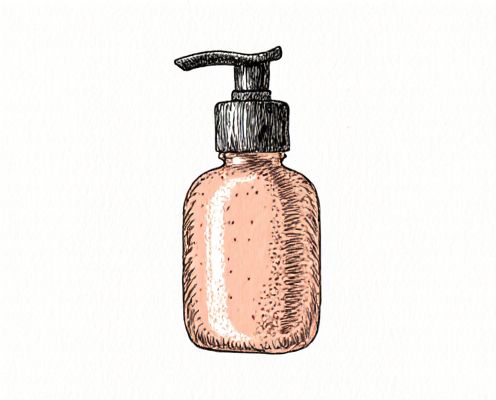
Fungal acne Illustration
Fungal acne is a skin condition caused by the overgrowth of yeast on the skin, leading to small, itchy, and uniform pimples that often appear on the forehead, chest, and back. Unlike regular acne, fungal acne does not respond well to traditional acne treatments and requires antifungal skincare products for effective management. Maintaining a clean, moisture-balanced skincare routine helps prevent the recurrence of fungal acne by limiting yeast proliferation.
Understanding Fungal Acne: What Every Woman Should Know
Fungal acne, caused by the overgrowth of Malassezia yeast on the skin, often manifests as itchy, uniform pustules primarily on the forehead, chest, and back. Unlike typical acne, fungal acne does not respond to standard acne treatments and requires antifungal skincare products containing ingredients like ketoconazole or selenium sulfide. Understanding the role of skin microbiome balance and avoiding heavy, oily cosmetics can help prevent flare-ups and maintain healthy skin.
Common Causes of Fungal Acne in Women's Beauty Routines
Fungal acne often results from the overuse of heavy skincare products containing oils or fatty acids that create a breeding ground for Malassezia yeast. Humid environments and excessive sweating during workouts contribute to clogged pores and fungal growth, especially when products like occlusive moisturizers or thick sunscreens are applied. Poor hygiene practices, such as infrequent cleansing or using contaminated makeup brushes, further exacerbate fungal acne in women's beauty routines.
Recognizing Symptoms: How to Identify Fungal Acne
Fungal acne, also known as Malassezia folliculitis, manifests as small, uniform red or flesh-colored bumps often accompanied by itchiness and a burning sensation on the chest, back, and face. Unlike traditional acne, fungal acne does not respond well to typical acne treatments and tends to worsen in hot, humid environments. Identifying fungal acne involves noting persistent, itchy pustules and a lack of blackheads or whiteheads, which helps differentiate it from bacterial acne outbreaks.
Fungal Acne vs. Traditional Acne: Key Differences
Fungal acne, caused by an overgrowth of yeast called Malassezia, differs from traditional acne, which primarily involves bacteria like Propionibacterium acnes. Unlike traditional acne, which often presents with whiteheads and blackheads, fungal acne typically appears as small, uniform pustules and itchy bumps concentrated on the chest, back, and forehead. Treatment for fungal acne requires antifungal agents rather than conventional acne medications such as benzoyl peroxide or salicylic acid, which can exacerbate fungal infections.
Beauty Products That May Trigger Fungal Acne
Certain beauty products containing heavy oils, esters, and fatty acids can trigger fungal acne by promoting yeast overgrowth on the skin. Ingredients such as oleic acid, polysorbates, and certain emollients found in moisturizers, sunscreens, and makeup are common culprits. To protect your skin, carefully review product labels and choose formulations labeled as non-comedogenic or fungal acne-safe.
Skincare Habits to Prevent Fungal Acne in Women
Maintaining proper skincare habits is essential to prevent fungal acne in women by keeping the skin clean and balanced. Using gentle, non-comedogenic cleansers and avoiding heavy, oil-based products helps reduce fungal overgrowth on the skin. Incorporating antifungal ingredients like zinc pyrithione or ketoconazole in skincare routines can effectively inhibit fungal proliferation and promote clearer skin.
Ingredients to Avoid for Fungal Acne-Prone Skin
For fungal acne-prone skin, avoid ingredients such as esters, polysorbates, and fatty acids like oleic acid that can feed Malassezia yeast and worsen breakouts. Look out for common culprits including isopropyl myristate, lauric acid, and certain oils like coconut and olive oil, which may exacerbate fungal acne. Ensuring your skincare routine excludes these components helps protect your skin from irritation and promotes clearer, healthier complexion.
Effective Treatments for Fungal Acne: Top Recommendations
Effective treatments for fungal acne include antifungal topical creams containing ketoconazole, clotrimazole, or ciclopirox, which target Malassezia yeast responsible for breakouts. Oral antifungal medications like fluconazole or itraconazole may be prescribed for persistent or widespread cases, enhancing treatment efficacy. Incorporating gentle, pH-balanced cleansers and avoiding oily skincare products also helps prevent fungal acne flare-ups and supports skin barrier health.
Best Skincare Routines for Managing Fungal Acne
Effective skincare routines for managing fungal acne prioritize gentle, non-comedogenic products that reduce Malassezia yeast overgrowth, a common cause of fungal acne. Incorporate antifungal cleansers containing ingredients like ketoconazole or zinc pyrithione to cleanse without disrupting the skin's natural barrier. Regular exfoliation with mild chemical exfoliants such as salicylic acid helps prevent clogged pores while maintaining hydration to support skin healing and prevent flare-ups.
Expert Tips for Clear and Healthy Skin
Effective treatment of fungal acne involves using antifungal shampoos or creams containing ketoconazole or clotrimazole to eliminate Malassezia yeast. Maintaining a consistent skincare routine with non-comedogenic, oil-free products helps prevent pore clogging and reduces fungal growth. Expert tips emphasize avoiding heavy moisturizers and occlusive ingredients to promote clear, healthy skin while supporting the skin's natural barrier.
 womendy.com
womendy.com